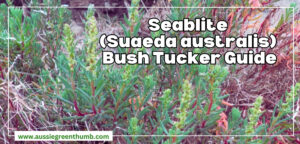It’s no secret that hydrangeas went out of fashion, as a generation of gardeners sought to modernise their outdoor spaces and steer away from the bright, even garish, flowers of their parents' and grandparents’ gardens.
Thankfully, they’ve made a comeback, with more and more gardeners looking for ways to encourage wildlife and prolong drama in their gardens.
More importantly, the range of hydrangeas on offer in garden centres is just incredible, and our understanding of their colours, their flower forms and their growth habits has come on leaps and bounds.
In this article, we’re going to share all of our favourite growing tips for hydrangeas, and clarify the differences between each species.
More...
Family: | Hydrangeaceae |
|---|---|
Genus: | Hydrangea |
Common Names: | Hydrangea, hortensia |
Location: | Outdoor |
Type: | Deciduous shrub |
Growth: | 2mx2m |
Sun requirements: | Partial shade (ideally afternoon shade) |
Foliage Colour: | Green |
Flower Colour: | White, blue, or pink |
Flowering: | late spring – late summer |
Fruit: | None |
Maintenance level: | Low |
Poisonous for pets: |
What are Hydrangeas?

Hydrangeas are a varied genus of flowering plants, with clear distinctions between each species. With traditional French hydrangeas hosting swathes of bushy pom-pom flowers right through summer, and more delicate lacecap hydrangeas which capture the delicate evening sun.
Hydrangeas are deciduous, so lose their leaves in winter, but they are completely hardy in Australia, so need very little care, other than watering through dry weather once established.
Hydrangea’s Natural Habitat
Hydrangeas are widespread in nature, and commonly found growing wild through Asia and the Americas in both sunny and shady positions.
They prefer moisture-retentive soil wherever they are found and have flowers which are heavily influenced by the acidity of alkalinity of their soil.
Most species of hydrangeas are found in China and throughout the Himalayas, though climbing hydrangeas prefer milder climates and are typically found around Japan and Korea.
Different Types of Hydrangeas
There are six groups of hydrangeas available in most garden centres today, though over 75 species exist in nature. Below, we’ll look at the key differences between the most common garden hydrangeas.
Hydrangea petiolaris |  |
Hydrangea ‘Mophead’(Mophead Hydrangeas)Mophead hydrangeas, also known as French hydrangeas, have loose balls of flowers, all bursting from a single tip. While each flower is distinct from the nest, they will flower together. Deadheading spent, or fading flowers can help to prolong their flowering season. | 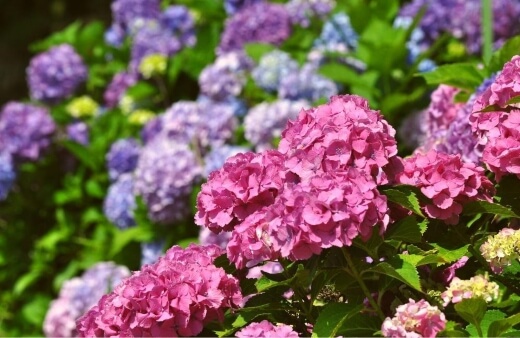 |
Hydrangea ‘Lacecap’ | 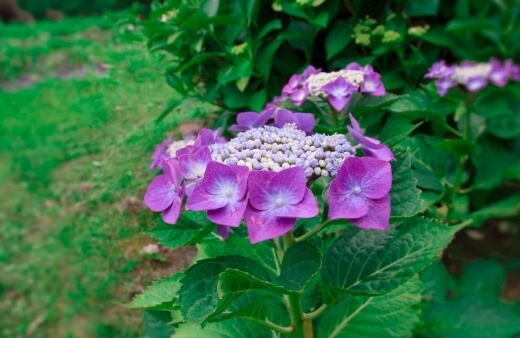 |
Hydrangea paniculata(Panicle Hydrangeas)Panicle hydrangeas are relatively new in our gardens, though the species (paniculata) is naturally occurring. They flower in a similar way to mopheads, with dense clusters of identical flowers, opening together, but are distinctly cone-shaped. | 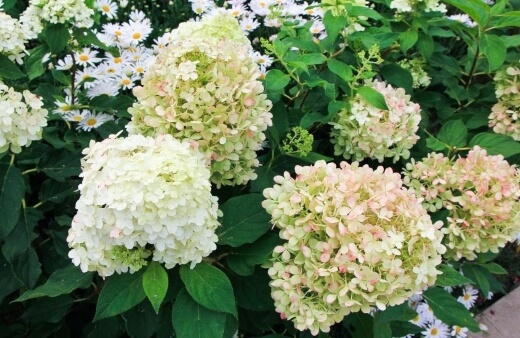 |
Hydrangea arborescens | 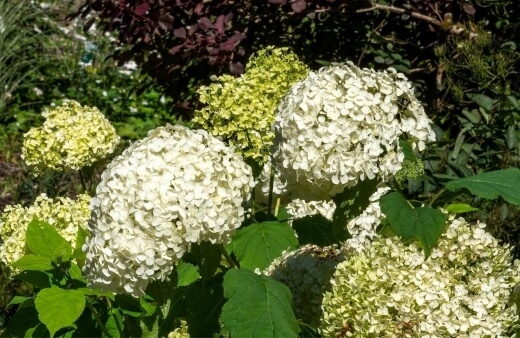 |
Hydrangea quercifolia |  |
Hydrangea petiolaris (Climbing Hydrangeas)

Climbing hydrangeas are spectacular and vastly underappreciated. They can climb up to 20ft in good conditions and are particularly easy to care for. Most climbing hydrangeas are lacecaps, but some host the iconic pom pom flowers too.
Hydrangea ‘Mophead’ (Mophead Hydrangeas)

Mophead hydrangeas, also known as French hydrangeas, have loose balls of flowers, all bursting from a single tip. While each flower is distinct from the nest, they will flower together.
Deadheading spent, or fading flowers can help to prolong their flowering season.
Hydrangea ‘Lacecap’ (Lacecap Hydrangeas)

Lacecap hydrangeas are part of the same species group as mopheads, but flower in a gorgeous domed form, with smaller flowers in the centre, and a ring or wider blooms around the edge of each cluster.


Get Your Free Guide:
Master Growing Australian Natives eBook
A Must Have Complete Guide for Every Australian Garden
Get Your Free Guide:
Master Growing Australian Natives eBook
A Must Have Complete Guide for Every Australian Garden
They are deciduous, and like a good mulch in spring to help keep moisture in the soil.
Hydrangea paniculata (Panicle Hydrangeas)

Panicle hydrangeas are relatively new in our gardens, though the species (paniculata) is naturally occurring. They flower in a similar way to mopheads, with dense clusters of identical flowers, opening together, but are distinctly cone-shaped.
Hydrangea arborescens (Smooth Hydrangeas)

Smooth hydrangeas have dense mops of flowers, tightly clustered and gorgeously structural in form. While deadheading can slightly prolong flowering, we prefer to keep spent flowers on as they hold their shape through winter and provide a home for insects, as well as providing structure in the garden over winter.
Hydrangea quercifolia (Oakleaf Hydrangeas)

Oakleaf hydrangeas, as the same suggests, are defined by their foliage rather than their flower. Their flower forms can be mopheaded, panicled, smooth, or lacey.
While their foliage is more similar to sycamore than oak, their fanned leaves add interest to summer borders.
How to Grow Hydrangeas
Hydrangeas are best grown from young plants, transplanted into the garden in spring, and watered well for their first year. They remain a popular garden plant because they are easy to care for, and will bloom in most conditions.
To get the most out of your hydrangea though, follow our growing guide below.

Planting Hydrangeas
The best time to plant hydrangeas is in early spring or late winter when the soil is cooler, and the roots have time to establish with slightly higher rainfall.
It is, however, possible to plant hydrangeas in summer or autumn, provided you water them really well with at least two buckets of water. Mature hydrangeas are slow rooting and grow about 1-2ft per year, which I then pruned back.
Young hydrangeas are hungry plants though and need large planting holes with plenty of organic matter mixed through to encourage their roots to establish.
Dig a planting hole at least twice the size of the root ball, and plant the hydrangea level with the soil. Create a small mound of compost around the plant, leaving a bowl around the stem so you can water generously directly at the base.
This prevents water run-off and allows you to target watering for the first few months. Traditionally, hydrangeas were planted just below the soil level, but this can cause young stems to rot, so keep any stems above ground level.
Light Preference
Hydrangeas prefer light shade, where moisture stays in the soil and won’t easily evaporate. Their thin, papery, foliage is delicate and wilts quickly in full sun.
Try to find a spot in the garden that gets around 6 hours of light, ideally in direct morning and evening sun, but protected from midday and early afternoon rays.
Best soil for Hydrangeas
Hydrangeas will grow on any soil other than sand. They like good, reasonable drainage, but need access to water at all times. Compacted soils or loamy, humus-rich soil is ideal.
You will regularly find hydrangeas in new builds because they can cope with the poor soil, and soil, compacted earth beneath the garden.
Even in our old property, we grow hydrangeas in a raised bed filled with compacted builders' waste and clay, which drains slowly, and holds moisture even in the baking sun.
Acid or alkaline soil for hydrangeas?
As well as considering drainage, it’s really important to find the right pH balance for hydrangeas. The pH of your soil drastically affects hydrangea flower colour but does not limit their flowering potential.
For example, Hydrangea macrophylla will flower blue on acid soil (5.5 pH), and pink on alkaline soil (7.5 pH or higher) soil. PH in the middle will produce white or purple flowers depending on the cultivar.
This unique trait is a wonderful reason to grow hydrangeas and can be controlled with mulches even on mature plants.
Growing Hydrangeas in Pots
Hydrangeas are happiest in the ground but can be planted in pots, provided they are watered well at least once a week. Choose a pot at least twice the size of the root ball and add crocks to the base.
Then fill it with moisture-retentive compost. Leave two inches at the top of the pot so you can fill it to the brim with water once a week.
How to Propagate Hydrangeas
Hydrangeas can be grown from seed, cuttings, and layering, and often create their own ‘volunteers’ without any effort at all. Below, we’ll look at each method in detail, but layering is by far the easiest route to take if you have access to existing plants.

Propagating Hydrangeas from Seed
You won’t find hydrangea seeds in garden centres or from reputable sellers online, so the only way to get seeds is to harvest them yourself. Hydrangeas have a mix of sterile and non-sterile flowers, making up each bloom cluster.
The flowers at the centre are generally fertile, but they differ based on the variety (lacecap hydrangeas are always fertile at the centre).
When hydrangeas have dried in autumn, or late summer in dry climates, shake the flowerhead into a paper bag. The ripe seeds are black and easy to spot amongst the brown, papery petals, and are usually around 5mm long.
To sow hydrangea seeds, you will need:
- 1 seed tray
- Sieved garden compost
- Garden soil
Method:
- Fill a seed tray with a 50:50 mix of compost and soil from the garden (having sieved any large chunks or stones out)
- Sow hydrangea seeds thinly on the surface (about 2” apart)
- Water well with the rose on your watering can
- Leave on a warm windowsill, and keep the soil moist
- Germination takes 14-21 days
- When plants are big enough to handle, transplant them to small pots
- Care for the young plants in these small pots for the next 18 months (water regularly, keep somewhere shaded, but warm outdoors).
Hydrangea Propagation from Cuttings
Hydrangea cuttings are easiest in early spring when new green shoots are starting to appear. Simply remove 5-6” of the fresh green growing tips with clean, sharp secateurs, then remove all but the top-most leaves.
If you are on the market for one, see our product reviews and buying guide for the best secateurs available in Australia.
Fill a small pot with free-draining compost, and push 2-3 cuttings into the container. Water your cuttings well, and leave them somewhere bright, but away from the direct afternoon sun.
Either store them in a cold frame, or cover the pots with clear plastic bags to help raise the humidity, and stop the leaves from drying too quickly.
How to Propagate Hydrangeas from Layering
Layering hydrangeas is really simple but requires a little bit of planning ahead. Layering is the process of creating new plants, without detaching any growth from the parent plant.
It required flexible shoots near ground level and loose, rich compost around the base of your plant.
To prepare a hydrangea for layering:
- In mid-summer, cut back a main shoot of a mature hydrangea right to the ground. This promotes vigorous new growth that will stay supple through winter.
- Next spring, dig good compost through the first couple of inches of soil around the base of the plant.
- Bend the flexible green shoots down to the ground, and peg it in place.
- Peg the stem next to a leaf or node, and nick it with a clean knife, just above the node.
- Cover with compost and water well.
- In late summer or early spring the next year you should have a healthy plant with a completely separate root system from its parent.
- Dig it up, and plant it wherever you like!
Caring for Hydrangeas
Mature hydrangeas in the garden are generally quite resilient, and will recover from drought, and heatwaves, and have even been known to regrow from the ground after fires, so there is very little you can do to kill a hydrangea.
But, let’s talk about how to keep hydrangeas thriving rather than surviving.
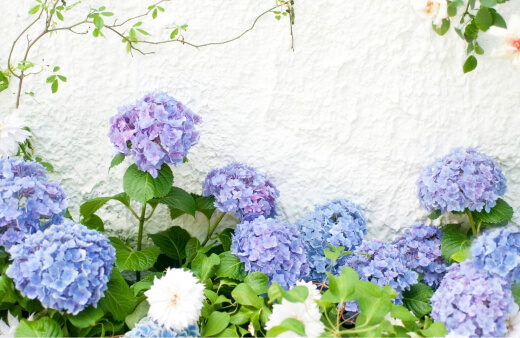
Mulching Hydrangeas
There are two reasons to mulch hydrangeas. They like moisture at their roots, and mulching can actively change and adapt their flower colour, depending on what you use.
An alkaline mulch, like rotted manure, will encourage pink flowers. An acid soil produces blue flowers. Technically, a blue hydrangea is flowering at its best, as hydrangeas need aluminium for healthy blooms, and this is more available in slightly acidic soils.
Finding a balance of acid and alkaline, by regularly mulching with neutral garden compost will produce white, or pale blue flowers. Check out our guide on the types of mulches to learn when and how to use them in your garden.
What Fertiliser to Use
Hydrangeas don’t need any specific fertilisers to support growth, but you can add coffee ground or tea bags to the base of the plant, which slowly leech gentle acidity to the roots. This helps produce vivid blue flowers the following summer.
Purpose-made hydrangea fertilisers can be bought to encourage either flower colour, but the best are those that contain trace aluminium, which help to boost the aluminium content in the soil, as well as slightly acidify the soil so roots can uptake the mineral.
Watering Hydrangeas
Hydrangeas will wilt dramatically in warm weather, so try to keep them shaded, and give them a really good drink once a week in summer. Avoid watering hydrangeas in winter as they are dormant, so need nothing more than natural rainfall to maintain soil structure.
Rainwater is better than tap water for hydrangeas as it is slightly acidic, as opposed to natural tap water which is slightly alkaline.
Pruning and Repotting Hydrangeas
If you notice the leaves on a potted hydrangea turning yellow this is usually due to restricted roots or dry soil. Repot your hydrangea into a large container in spring or summer, and it will quickly bounce back.
To encourage flowering and maintain form, prune hydrangeas any time from autumn to late winter. You can cut back into any green stem to promote regrowth. Cutting dead wood will limit the size and shape.
Once a year, in summer, remove old dead wood from the centre of hydrangeas to help improve airflow.
Hydrangea Pests and Diseases
Hydrangeas rarely suffer from pests or diseases, but there are a few problems that occur after dry spells or particularly humid weather patterns. Healthy hydrangeas are unlikely to be damaged by any pests, and diseases are simple to treat.
Hydrangea pests include scale, weevils, leaf tiers, rose chafers, Japanese beetles, spider mites and root-knot nematodes. All are a symptom of a wider problem, rather than the cause.
Hydrangea scale
Also known as oyster shell scale, the hydrangea scale insect thrive on healthy hydrangeas. They rarely cause lasting damage, and at worst create minor fungal spots on the leaves after heavy rain.
Scales are similar to the mealybugs found commonly on tropical plants, and can simply be washed off hydrangeas with a strong jet from a hose.
To limit the damage done by scale insects on hydrangeas, spray a mix of baking soda and water over the leaves. This dries out fungal spores and prevents them from reproducing.
Vine weevil
Black vine weevil (Otiorhynchus sulcatus) is a common hydrangea pest, and feeds on the leaves of plants. While they can spread disease by carrying them from one plant to another, they are harmless.
The most common damage from vine weevils is misshapen leaves, where they have eaten holes around the edges.
Hydrangea leaf tiers
While leaf tiers won’t cause long-term damage to hydrangeas, they do limit photosynthesis and put strain on the roots, redirecting nutrients to help leaves recover.
This can reduce flowers. If you notice leaf tiers (Olethreutes ferriferana), remove them, and the leaves affected and dispose of them (put the whole bundle of leaves and caterpillars on the bird table.
Birds will eat the bugs, and use the leaves for nesting.
Other pests
- Rose chafer
- Japanese beetles
- Two-spotted spider mite
- Root-knot nematodes

It’s only in extreme conditions that hydrangeas suffer from diseases, but if you find your hydrangea covered in damaged foliage, brown spots, or wilting with yellow leaves, there are a few things you can do.
Botrytis blight
Botrytis blight is a common fungal disease that affects most garden plants in damp, humid conditions. To prevent botrytis, avoid overwatering hydrangeas, and do not water the foliage.
Where insects have caused damage to green stems or new foliage, wet leaves create humidity that promotes bacteria and fungus to enter their damaged leaves.
Flowers and flower buds will develop grey mould, and fail to open as a result of botrytis blight on hydrangeas. To treat botrytis, remove any affected growth, and treat the rest of the plant with an organic fungicide.
Then, stop watering until the soil dries out.
Powdery mildew
Powdery mildew is a similar problem to botrytis and creates a thin film of powdery mould across the surface of hydrangea leaves. As with most fungal problems, hydrangea will usually recover in warmer weather. Treatment is the same as botrytis.
Leaf spot
There are many fungi that cause leaf spot on hydrangea, but the most common is Cercospora. The treatment is the same as botrytis and mildew – remove affected foliage, and spray an organic fungicide over the rest of the plant.
Frequently Asked Questions About Hydrangea
How long does it take for hydrangea to grow to its full size?
Hydrangeas grow quickly when they are planted into the garden, and will generally grow to their full size in around 2-4 years. Once they reach their ultimate height, they can be pruned and tend to grow back slowly, at around 1-2ft per year.
Do hydrangeas prefer sun or shade?
Hydrangeas prefer partial shade but can cope with full sun provided they are regularly watered to help prevent leaf wilt. Hydrangeas grown in shade can shoot out erratically, so finding the right balance of sun and shade is important for these low-maintenance plants.
How long does it take hydrangea to flower?
Hydrangeas will usually flower in their second year from cuttings, or in their third year when grown from seed. Once a root system in established hydrangeas are fast to flower and produce reliable blooms every year.
What happens if you don’t prune hydrangea?
There are some hydrangeas that flower in old wood. These varieties do not need pruning and are better left alone other than pruning dead or diseased stems.
For hydrangeas that flower on new growth, they will flower less prolifically if left unpruned for several years.
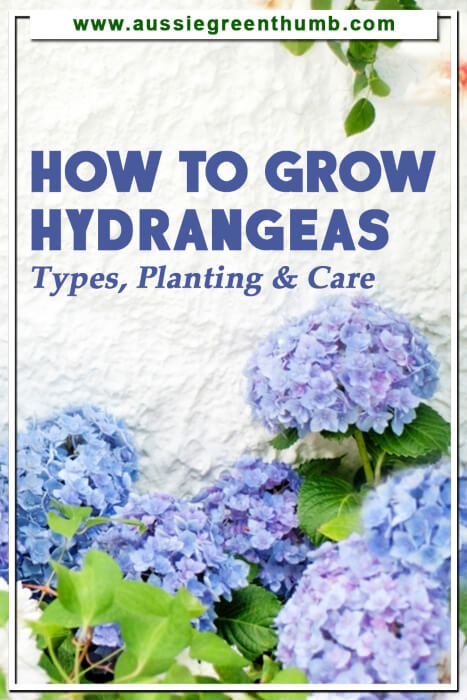
Start Growing Bountiful Hydrangeas in Your Garden
Hydrangeas are brilliant plants for any gardener planning a high-impact, long-season garden. Hydrangeas work hard to earn their place in the garden and are easy to maintain, with high rewards for weekly water.
Provided you’ve got the basics of how to grow hydrangeas down, there’s not much you can do wrong. Just make the most of these gorgeous shrubs, and consider leaving their flowers in place through winter to provide habitat for local wildlife. You are now all set to grow hydrangeas in your garden.
Published on August 3, 2022 by Maisie Blevins
Last Updated on February 22, 2025


